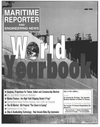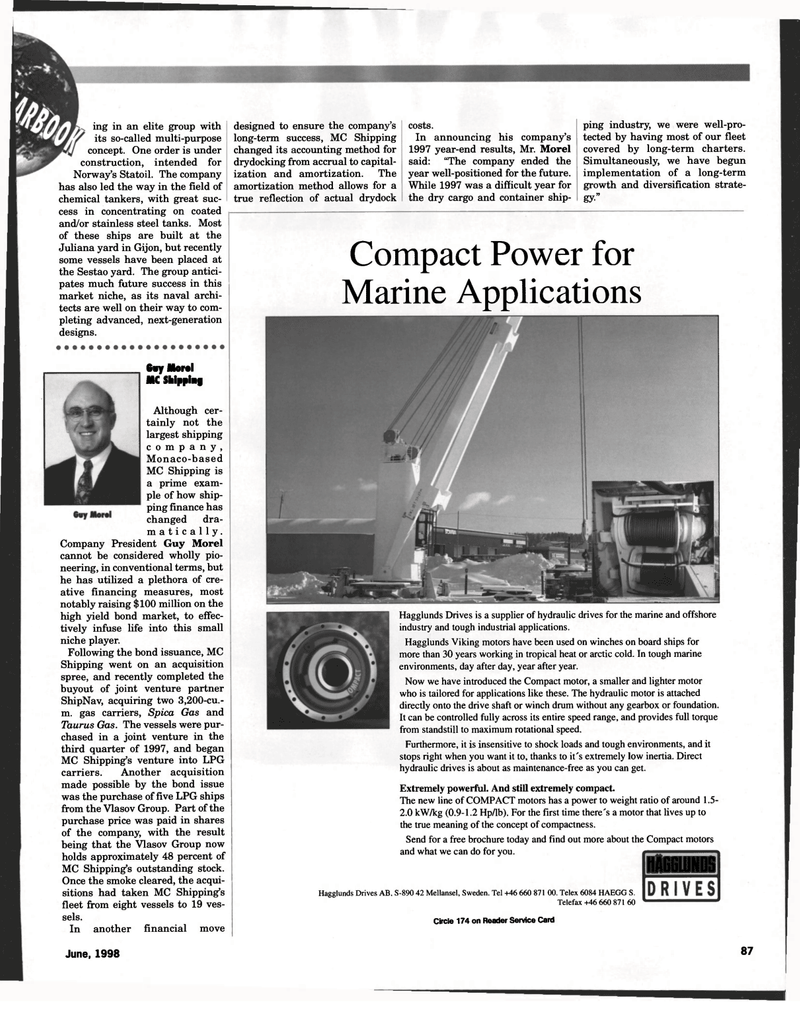
Page 56: of Maritime Reporter Magazine (June 1998)
Read this page in Pdf, Flash or Html5 edition of June 1998 Maritime Reporter Magazine
ing in an elite group with its so-called multi-purpose concept. One order is under construction, intended for
Norway's Statoil. The company has also led the way in the field of chemical tankers, with great suc- cess in concentrating on coated and/or stainless steel tanks. Most of these ships are built at the
Juliana yard in Gijon, but recently some vessels have been placed at the Sestao yard. The group antici- pates much future success in this market niche, as its naval archi- tects are well on their way to com- pleting advanced, next-generation designs.
Guy Moral
MC Shipping
Although cer- tainly not the largest shipping company,
Monaco-based
MC Shipping is a prime exam- ple of how ship- ping finance has changed dra- matically.
Company President Guy Morel cannot be considered wholly pio- neering, in conventional terms, but he has utilized a plethora of cre- ative financing measures, most notably raising $100 million on the high yield bond market, to effec- tively infuse life into this small niche player.
Following the bond issuance, MC
Shipping went on an acquisition spree, and recently completed the buyout of joint venture partner
ShipNav, acquiring two 3,200-cu.- m. gas carriers, Spica Gas and
Taurus Gas. The vessels were pur- chased in a joint venture in the third quarter of 1997, and began
MC Shipping's venture into LPG carriers. Another acquisition made possible by the bond issue was the purchase of five LPG ships from the Vlasov Group. Part of the purchase price was paid in shares of the company, with the result being that the Vlasov Group now holds approximately 48 percent of
MC Shipping's outstanding stock.
Once the smoke cleared, the acqui- sitions had taken MC Shipping's fleet from eight vessels to 19 ves- sels.
In another financial move designed to ensure the company's long-term success, MC Shipping changed its accounting method for drydocking from accrual to capital- ization and amortization. The amortization method allows for a true reflection of actual drydock costs.
In announcing his company's 1997 year-end results, Mr. Morel said: "The company ended the year well-positioned for the future.
While 1997 was a difficult year for the dry cargo and container ship- ping industry, we were well-pro- tected by having most of our fleet covered by long-term charters.
Simultaneously, we have begun implementation of a long-term growth and diversification strate- gy."
Hagglunds Drives is a supplier of hydraulic drives for the marine and offshore industry and tough industrial applications.
Hagglunds Viking motors have been used on winches on board ships for more than 30 years working in tropical heat or arctic cold. In tough marine environments, day after day, year after year.
Now we have introduced the Compact motor, a smaller and lighter motor who is tailored for applications like these. The hydraulic motor is attached directly onto the drive shaft or winch drum without any gearbox or foundation.
It can be controlled fully across its entire speed range, and provides full torque from standstill to maximum rotational speed.
Furthermore, it is insensitive to shock loads and tough environments, and it stops right when you want it to, thanks to it's extremely low inertia. Direct hydraulic drives is about as maintenance-free as you can get.
Extremely powerful. And still extremely compact.
The new line of COMPACT motors has a power to weight ratio of around 1.5- 2.0 kW/kg (0.9-1.2 Hp/lb). For the first time there's a motor that lives up to the true meaning of the concept of compactness.
Send for a free brochure today and find out more about the Compact motors and what we can do for you. HAGGLUNDS
Compact Power for
Marine Applications
Hagglunds Drives AB, S-890 42 Mellansel, Sweden. Tel +46 660 871 00. Telex 6084 HAEGG S.
Telefax +46 660 871 60
Circle 174 on Reader Service Card
June, 1998 87

 55
55

 57
57
